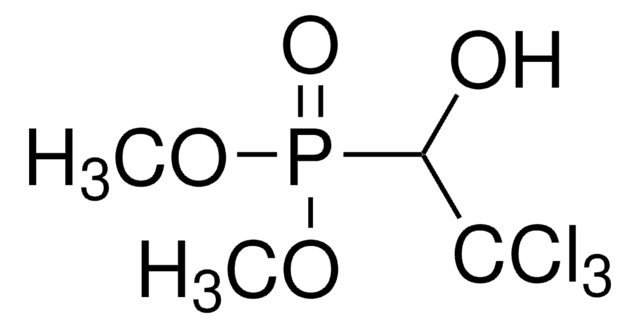CRM67618
Trichlorfon
certified reference material, TraceCERT®, Manufactured by: Sigma-Aldrich Production GmbH, Switzerland
Synonym(e):
(2,2,2-Trichlor-1-hydroxyethyl)-phosphonsäure-dimethylester, Metrifonat
About This Item
Empfohlene Produkte
Qualität
certified reference material
TraceCERT®
Qualitätsniveau
Produktlinie
TraceCERT®
Haltbarkeit
limited shelf life, expiry date on the label
Hersteller/Markenname
Manufactured by: Sigma-Aldrich Production GmbH, Switzerland
Format
neat
Lagertemp.
−20°C
SMILES String
COP(=O)(OC)C(O)C(Cl)(Cl)Cl
InChI
1S/C4H8Cl3O4P/c1-10-12(9,11-2)3(8)4(5,6)7/h3,8H,1-2H3
InChIKey
NFACJZMKEDPNKN-UHFFFAOYSA-N
Suchen Sie nach ähnlichen Produkten? Aufrufen Leitfaden zum Produktvergleich
Allgemeine Beschreibung
Certified content by quantitative NMR incl. uncertainty and expiry date are given on the certificate.
Download your certificate at: http://www.sigma-aldrich.com
Trichlorfon is a broad-spectrum organophosphate insecticide used for the protection of a variety of fields and fruit crops. It is also used against fish parasites in aquaculture. It inhibits the activity of acetylcholinesterase (AChE) and causes the acetylcholine (ACh) to accumulate in the nerve synapses thereby disrupting nerve function.
Trichlorfon is not approved for use in the European Union (EU) as a plant protection agent under Regulation (EC) No. 1107/2009, repealing directive 91/414/EEC. But a default maximum residue limit (MRL) of 0.01 mg/kg and 0.02 mg/kg is set for its presence in fresh/frozen fruits and tree nuts respectively as per the Reg. (EU) No 899/2012.
Anwendung
The trichlorfon CRM may also find the following uses:
- Determination of trichlorfon in leek and cucumber samples by direct competitive biomimetic immunosorbent assay based on the use of a molecularly imprinted polymer
- Development of a biomimetic immunoassay-capillary electrophoresis (BI-CE) method using quantum dot (QD) labels to determine trichlorfon in carrot, zucchini, edible rape, and leek samples
- Analysis of phthalates and 18 insecticide residues in 46 different samples of shrimps using liquid/gas chromatography-tandem mass spectrometry (LC/GC-MS/MS) for the risk assessment of compounds on human health
- Multi-residue determination of 238 pesticides and 78 veterinary drugs in 80 bovine milk samples by ultra-fast liquid chromatography-tandem mass spectrometry (UFLC-MS/MS) and gas chromatography-tandem mass spectrometry (GC-MS/MS)
- Evaluation of nanoflow liquid chromatography-mass spectrometry (LC-MS) to simultaneously determine 60 pesticide residues from different chemical classes in tomato, baby food, olive oil, orange, and fruit jam samples
- Validation of a liquid chromatography-tandem mass spectrometry (LC-MS/MS) method for detection and quantification of clanobutin, dichlorvos, and naftazone in pork, beef, chicken, milk, and egg samples
Empfohlene Produkte
Rechtliche Hinweise
Anwendung
Signalwort
Danger
H-Sätze
Gefahreneinstufungen
Acute Tox. 4 Dermal - Acute Tox. 4 Oral - Aquatic Acute 1 - Aquatic Chronic 1 - Resp. Sens. 1 - Skin Sens. 1
Lagerklassenschlüssel
11 - Combustible Solids
WGK
WGK 3
Flammpunkt (°F)
Not applicable
Flammpunkt (°C)
Not applicable
Choose from one of the most recent versions:
Analysenzertifikate (COA)
Don't see the Right Version?
If you require a particular version, you can look up a specific certificate by the Lot or Batch number.
Besitzen Sie dieses Produkt bereits?
In der Dokumentenbibliothek finden Sie die Dokumentation zu den Produkten, die Sie kürzlich erworben haben.
Chromatograms
application for LC-MS, application for SPEUnser Team von Wissenschaftlern verfügt über Erfahrung in allen Forschungsbereichen einschließlich Life Science, Materialwissenschaften, chemischer Synthese, Chromatographie, Analytik und vielen mehr..
Setzen Sie sich mit dem technischen Dienst in Verbindung.








